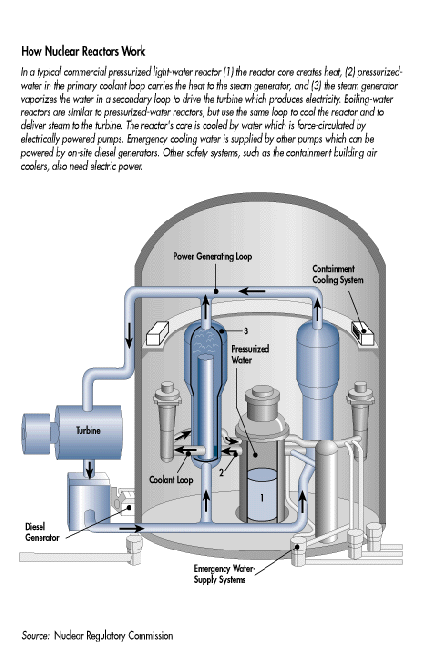|
The Safety Issue How safe are the reactors at Juragua? An official
in the Cuban Foreign Ministry stated the powerplant could withstand volcanoes,
tidal waves, and earthquakes.(1) In the United States,
there are references to “ticking time bombs” and “the Cuban Chernobyl”
in the popular press. There is enough information available to raise some
concerns about the project, but not enough data to render a judgment.
Juragua’s Soviet VVER-440 reactors are superior in design and safer than the RBMK reactors installed at Chernobyl. (The VVER-440 design, including some of its safety features, is discussed in more detail in the Reactors section.) Advocates for completion of the Juragua reactor argue that 25 VVER-440 reactors are currently operable in the eastern hemisphere. Why are these two regarded as a problem? One counter-argument is that although the design is identical, such factors as quality control, regulatory control, and the conditions in which they will operate are not. The Soviet Union called upon vast resources of men, material, equipment, and technical expertise to contain the disaster at Chernobyl. Most importantly, the reaction was swift. To rapidly move comparable resources to Juragua, Cuba, might not be possible. A former Cuban technician stated that, together with a Soviet technician, he examined approximately 5,000 welds of pipes. Of these, 10 to 15 percent were defective. Another individual claimed that although defective welds were discovered in the containment dome, concrete was still poured.(2) In August 1993, GAO identified "a number of concerns"(3) about the entire Cuban nuclear program. The potential problems included not only those related to construction and quality control, but insufficient operator training and "the lack of a regulatory organization."(4) These concerns were also being felt in the Congress and in the White House. President Clinton publicly stated his opposition to completion of the project. In addition to his concerns about a possible nuclear accident, the President cited Cuba's refusal to sign the nuclear non-proliferation treaty.(5) Since the 1980's, the International Atomic Energy Agency (IAEA) approved nearly $680,000 for various technical assistance projects related to the Cuban reactors. The United States withheld about $2 million from its voluntary contribution to the fund between 1981 and 1995, money that “otherwise would have gone for nuclear technical assistance to Cuba."(6) The U.S. Department of State concluded that the IAEA programs were primarily to enhance safety and improve quality assurance, efforts generally supported by the United States. In 1996, the United States restored its contribution to the fund, providing $16 million (out of the total of $53 million).(7) Whatever impact a nuclear accident at Juragua would have on the United States, the impact would be significantly greater in Cuba. Cienfuegos is 180 miles from Key West, but it is even closer to Havana. Cuba is not unaware of the potential consequences of a nuclear disaster. At Tarara, a Cuban beach camp once used by stress victims from the volcanic island of Montserrat, thousands of Ukrainian school children receive care.(8) The safety concerns discussed here are based on publicly available information which may be incomplete. EIA does not have specific information on what steps Cuba, Russia, and the international community have taken to address the safety concerns. Issues that may lead to either the cancellation or completion of the reactors, such as safety and funding, are relevant to energy supply and demand and this Web Site. The merit or resolution of these issues, however, is not within the scope of the Energy Information Administration. Notes: 1. Shelley Emling, "Cuba Goes Ahead with Nuclear Plant Despite U.S. Objections," Cox News Service, November 25, 1996. 2. U.S. General Accounting Office, Testimony before the Subcommittee on the Western Hemisphere, Committee on International Relations, House of Representatives, "Nuclear Safety: Concerns with the Nuclear Power Reactors in Cuba," GAO/T-RCED-95-236, Statement of Keith O. Fultz, Assistant Comptroller General, Resources, Community, and Economic Development Division, August 1, 1995. 3. U.S. General Accounting Office, Testimony before the Subcommittee on the Western Hemisphere, Committee on International Relations, U.S. House of Representatives, "Nuclear Safety: Concerns with the Nuclear Power Reactors in Cuba," Statement of Keith O. Fultz, Assistant Comptroller General, Resources, Community, and Economic Development Division." August 1, 1995, p. 8. 5. British Broadcasting Corporation 6. U.S. General Accounting Office, Report to Congressional Requesters, Nuclear Safety: International Atomic Energy Agency’s Nuclear Technical Assistance for Cuba, March 1997, p. 3 8. Reuter, "Volcano Children to get Cuban Holiday," August 14, 1997.
|
